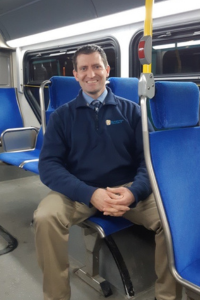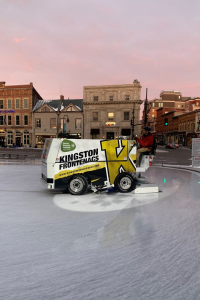The electric fleet transformation is a barnburner.
On March 5, 2019, the City of Kingston became the first municipality in Ontario to declare a climate change emergency. Since then, they’ve been hard at work transforming their municipal fleets to zero emission vehicles.

In 2021, two electric buses were added to the fleet, and the city is on track to add another five, pending approval through the federal government’s Investing In Canada Infrastructure program. “As part of our overall plan, the city’s goal is to have our entire fleet of 82 buses converted to non-diesel by no later than 2040,” says Jeremy DaCosta, Director of Transit for the City of Kingston, adding, “It may happen sooner than that.”
The two electric buses are manufactured by Winnipeg-based New Flyer, and are charged at two dispensers. “We have the ability to charge the buses we have, move them out of the way and charge some additional buses.” Moving forward, more dispensers will be added to allow for more buses charging simultaneously.
And the charging infrastructure is outside. “We wanted to test it in the true Canadian winter,” describes DaCosta.
Outdoor air temperature
There is some limitation to the distance the electric buses can travel. Currently, they’re assigned to morning and afternoon blocks. “Routes that run during our rush hour period go out, operate for several hours and then return to be charged,” explains DaCosta. As the weather gets warmer, buses can travel further, and can be assigned to route that stay out for longer periods of time.
The main factor driving the efficiency of the bus and the utilization of energy is the outdoor air temperature. The interior heat of the bus is driver by the electric battery, and when the electric heat needs to operate at a higher capacity, the distance that the bus can travel is reduced.

“It’s an added challenge in the transit world because of the stopping, starting with doors opening and closing,” notes DaCosta. “You’re doing that multiple times in an hour, so it’s more of a challenge to maintain the level of comfort inside the bus.”
But other electric vehicles don’t have that problem, like the fleet of electric Zambonis, or ice re-surfacers. The city of Kingston has a fleet of 12 ice re-surfacers distributed across city facilities. Right now, five of the 12 are electric, and there will be an additional two by the end of 2023.
The non-electric ice re-surfacers are powered by propane, and the plan is to replace existing units with electric units as needed, with the goal to fully convert by the end of 2026.
Reduction in costs
“It’s a great application for that type of product,” enthuses Brent Fowler, Director of Corporate Asset Management for the city of Kingston. The ice re-surfacers can be put right back on the charger after a “flood,” which means the job of re-surfacing an ice rink. To charge the equipment, the electrical infrastructure is conveniently right in the equipment room.

There are a number of financial benefits, including about a 35 percent reduction in maintenance costs, about an 80 percent reduction in energy costs. “It’s a very positive experience for the operator, if you can imagine having to change out propane cylinders, ” notes Fowler.
The community benefits from the cleaner air inside the arena, which also means there’s less stress on the arena HVAC system. “We have a great partner in Zamboni, they’re based nearby in Brantford and that helps with the adoption and training program.”
The electric ice re-surfacers are Zamboni 450 Lithium Ion models. “We recommend our operators charge after every flood, but they can actually operate and complete anywhere between eight to 10 floods before they need to be charged,” says Fowler.
Positive response
In addition to buses and ice re-surfacers, the city has invested in a wide range of electric light duty fleet vehicles. Recently, they took delivery of seven Hyundai Konas to add to the 24 already on duty, with 11 more zero emission vehicles arriving over the next few months. These include the Kona, a PHEV Ford Escape, and a Ford E-Transit cargo fan. The city also boasts Chevy Bolts, and a couple of Toyota Prius vehicles.
“By the end of 2023, we’ll have 35 light duty electric vehicles at the city,” asserts Fowler. These are used by various departments, including bylaw enforcement, parking enforcement, building and licensing services, the transit group, environmental services, as well as Utilities Kingston. The city has about 100 level 2 chargers across the city, and 50 of them are for public use. The other 50 are installed at city facilities, so vehicles they can be charged overnight.
“There’s been a positive response from all our departments,” reports DaCosta. “I don’t know of any other municipality our size that has this many light duty electric fleet assets.”



